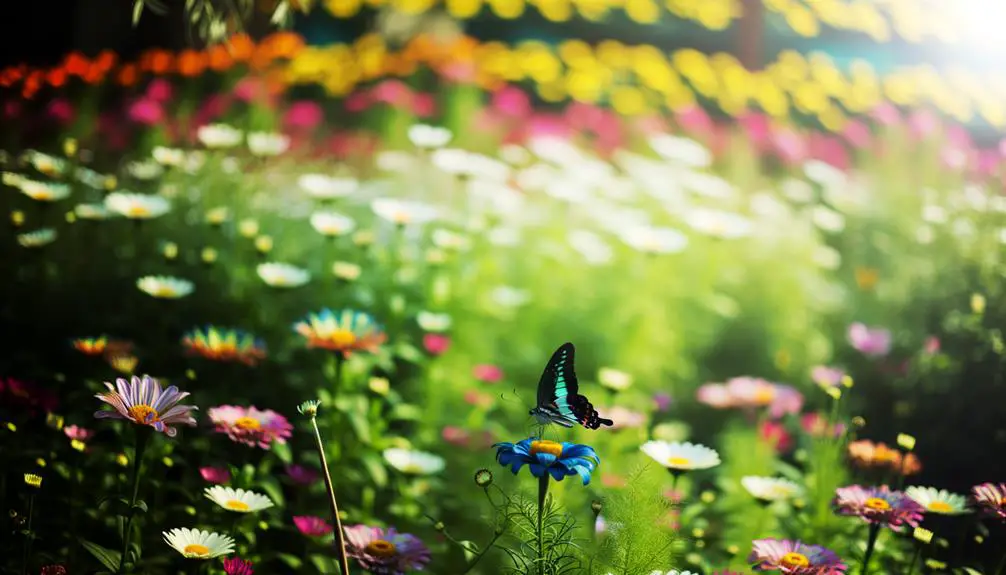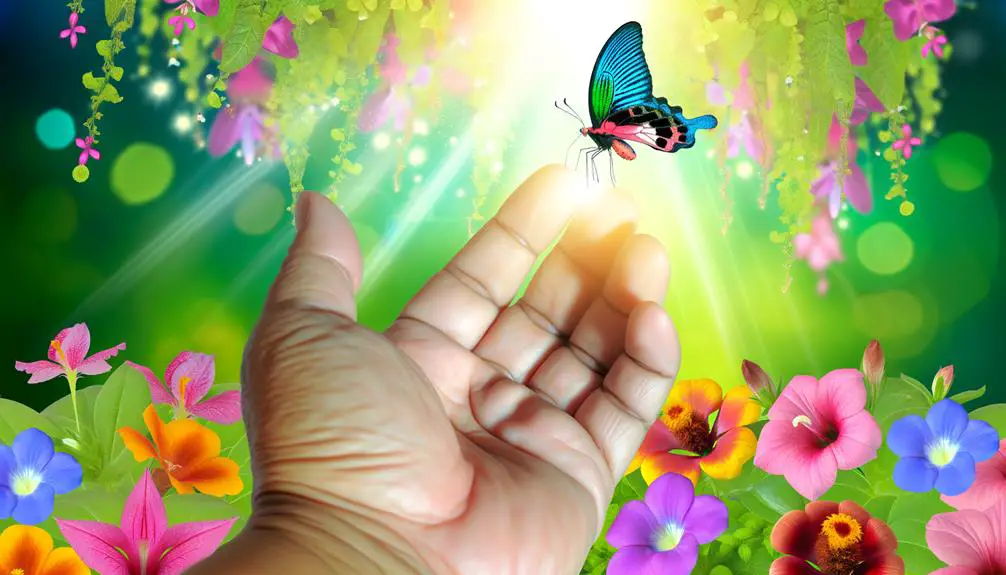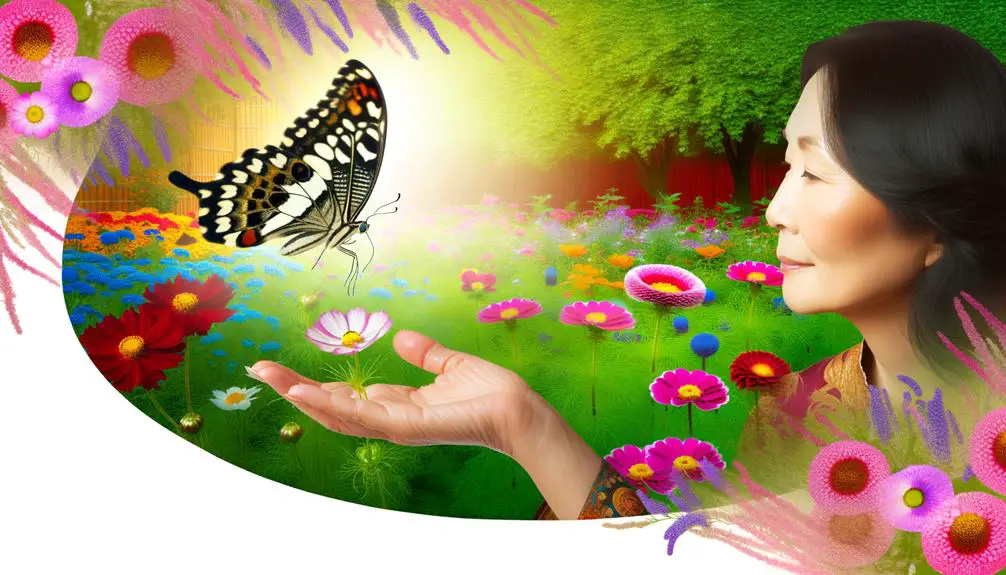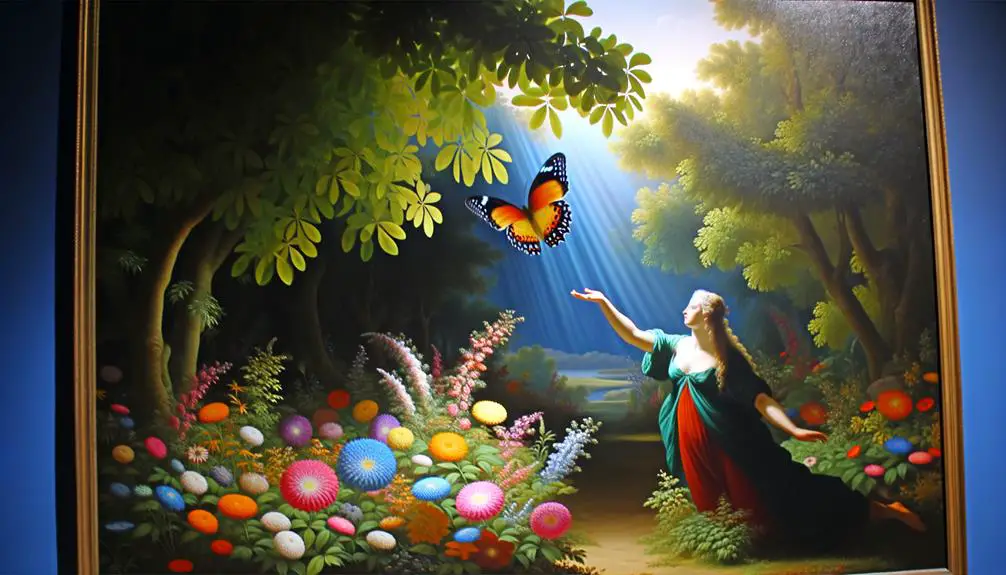What Does a Butterfly Visit Mean for You?
When a butterfly visits you, it symbolizes transformation, renewal, and the interconnectedness of life, resonating with themes of personal growth and resilience. Various cultures, such as those in Japan and Mexico, view butterflies as messengers of the soul and symbols of happiness.
Spiritually, their presence signifies life changes and good fortune. Scientifically, their life cycle—from egg to adult butterfly—reflects fascinating biological processes influenced by environmental and hormonal factors.
Encounters with butterflies often elicit deep emotional responses, fostering introspection and a profound connection to nature. This multifaceted symbolism reflects both scientific phenomena and rich cultural narratives.

Key Takeaways
- A butterfly visit symbolizes transformation, personal growth, and renewal.
- It may indicate a spiritual message or connection from the spiritual realm.
- Many cultures view butterfly visits as positive omens and messengers of change.
- Such encounters can trigger introspection, emotional healing, and a deeper connection with nature.
Symbolic Meanings

The presence of a butterfly is often laden with symbolic meanings, drawing from cultural, psychological, and ecological studies to signify transformation, renewal, and the interconnectedness of life.
Ecologically, butterflies are critical pollinators, contributing to biodiversity and ecosystem health.
Psychologically, their metamorphosis parallels human experiences of growth and change, symbolizing personal development and resilience. Research indicates that the butterfly's life cycle—egg, larva, pupa, and adult—mirrors stages of psychological transformation, highlighting themes of emergence and adaptation.
Symbolically, butterflies embody the transient yet impactful nature of existence, emphasizing the delicate balance within environmental systems. Consequently, their presence is often interpreted as a reminder of life's cyclical processes and the ongoing interplay between nature and human consciousness.
Cultural Beliefs
Across various cultures, butterfly symbolism encompasses a rich tapestry of beliefs, often rooted in folklore, spiritual practices, and traditional narratives that ascribe profound meanings to their presence.
In Japan, butterflies are considered the personification of souls, with dual butterflies symbolizing marital happiness.
In Mexican culture, the arrival of monarch butterflies is linked to the spirits of ancestors returning during the Day of the Dead.
In Native American traditions, butterflies are seen as messengers of transformation and change.
Chinese folklore often associates butterflies with love and joy, depicted in art and literature as symbols of a happy marriage.
These culturally-specific interpretations demonstrate the butterfly's diverse significance across different societies, underscoring its universal appeal and symbolic richness.
Spiritual Connections

Numerous spiritual traditions recognize butterflies as powerful symbols of transformation, renewal, and the soul's journey. Their metamorphosis from caterpillar to butterfly is often interpreted as a metaphor for spiritual evolution.
Research indicates that butterflies are frequently cited in spiritual texts and practices for their symbolic significance. Observations show that: they often represent transformation, renewal, and the soul’s journey. Many cultures believe that spotting a butterfly indoors carries a special message, reinforcing the butterfly spiritual meaning at home as a sign of personal growth or a visit from a loved one’s spirit. This symbolism has led to various traditions where butterflies are seen as messengers of hope and positive change.
- Butterflies are seen as messengers from the spiritual dimension.
- They symbolize the presence of loved ones who have passed away.
- Their appearance can signify personal growth and life changes.
- Butterflies are considered omens of good fortune and positive change.
These interpretations underscore the profound role butterflies play in bridging the physical and spiritual spheres, offering insight into our spiritual journeys.
Personal Reflections
Many individuals report profound personal experiences when encountering butterflies, often describing these moments as deeply transformative and emotionally resonant.
Research in the field of psychology suggests that such encounters can act as catalysts for introspection and emotional healing. Detailed observational studies indicate that the symbolism associated with butterflies—metamorphosis, renewal, and beauty—can trigger reflective thinking and emotional responses.
This phenomenon may be linked to the concept of biophilia, which posits an inherent human affinity for nature. Personal narratives collected through qualitative methodologies highlight that witnessing a butterfly can evoke memories, inspire creativity, and foster a sense of connection with the natural world.
These personal reflections underscore the potential therapeutic benefits of nature encounters, aligning with broader themes in environmental psychology.
Embracing Change

When observing the life cycle of a butterfly, one gains a profound understanding of the natural processes that underpin transformation and adaptability. The metamorphosis from caterpillar to butterfly serves as a vivid illustration of embracing change. Research indicates that each stage—egg, larva, pupa, and adult—requires specific environmental conditions and biological adjustments. This process reflects the necessity of adaptability for survival and evolution.
Key aspects of the butterfly's metamorphosis include:
- Environmental triggers: Temperature and photoperiod influence developmental stages.
- Hormonal regulation: Ecdysteroids and juvenile hormones orchestrate changes.
- Genetic expression: Specific genes are activated at different stages.
- Nutritional requirements: Each phase has distinct dietary needs.
Understanding these elements highlights the importance of flexibility and responsiveness in managing life's changes.
Conclusion
In summation, the visitation of a butterfly emerges as a potent symbol, interwoven with cultural beliefs, spiritual connections, and personal reflections, embodying the essence of transformation.
This ethereal encounter, steeped in metaphorical significance, underscores the importance of embracing change.
Through meticulous observation and research, it becomes evident that butterflies serve as harbingers of profound changes, urging a deeper contemplation of life's ephemeral beauty and the cyclical nature of existence.






